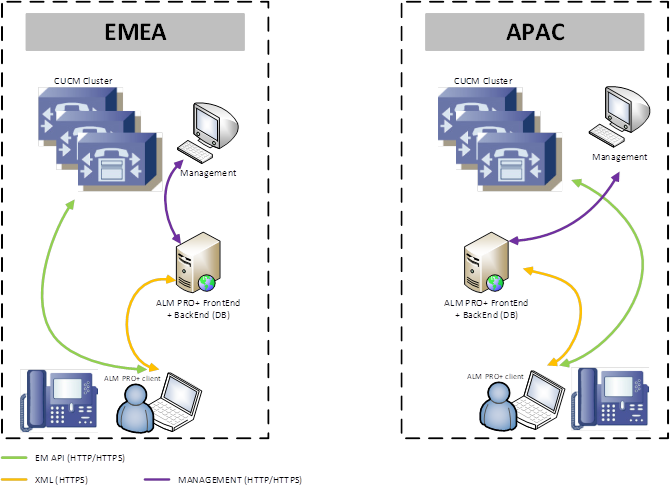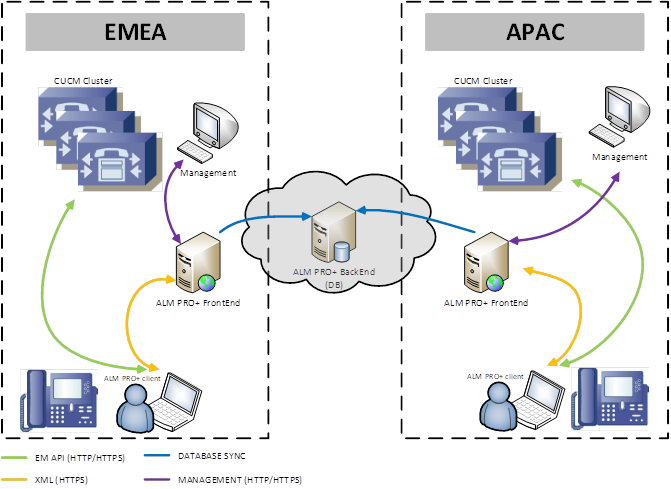
ALM PROplus High-level Architecture
ALM PROplus High-level Architecture
ALM High-level architecture
This document describes the high-level ALM PRO+ architecture. Which components are involved and how they communicate with other components within the network. Also, this document will provide an overview of the requirements and the data traffic flows between the components.
ALM PRO+
With ALM PRO+ organisations can now truly benefit from Extension Mobility using a localised or centralised solution for all ALM clients. ALM PRO+ is an add-on to ALM PRO and adds the following features:
- Centralised administration for all sites/locations using ALM PRO
- License management and control
- Advanced reporting on EM usage
- Extended management reporting options
- Calculating work space usage
- Manage user and group profiles
- Web-based administration
ALM PRO+ contains two major components:
- Frontend
The frontend contains the management interface. This is a web-portal based on HTTP and secure-HTTP. It allows administration of the licenses and the configuration for the ALM clients and allows administrators to generate several EM usage reports. - Backend
The backend is the database part of the system. This database contains all the configuration items, the license information and all the reporting records used by the frontend to generate reports.
Localized Solution
The localized solution requires one ALM PRO+ (front and backend) instance per CUCM Cluster. The ALM PRO+ Server is situated within the same network, or VLAN, as the CUCM Publisher Server.
- All ALM clients communicate with the corresponding CUCM EM Server, this is based on the ALM client settings (automatic or manual device detection)
- All ALM clients communicate with a single ALM PRO+ Server
- Each ALM PRO+ Server hosts the administration web portal and it also contains the reporting and configuration database
In the situation of multiple sites or regions, multiple ALM PRO+ servers must be deployed. There will be no synchronisation between these servers.
This is useful in situations where the ALM clients cannot communicate with other parts of the network across the WAN, for example if there is no routing available or if there are Firewall rules or ACL’s in place which prevent communication between these components.
Centralized solution
The centralized solution requires one ALM PRO+ Frontend instance per region. An ALM PRO+ Server should be situated within the same network or VLAN as the CUCM Publisher Server.
The ALM PRO+ backend database Server must be deployed at a centralised location, in a data centre, accessible to all ALM PRO+ frontend Servers. The physical location of this Server is not important, but the network infrastructure must allow communication between the ALM PRO+ frontend and ALM PRO+ backend.
- All ALM clients communicate with the corresponding CUCM EM Server, this is based on the ALM client settings (automatic or manual device detection)
- All ALM clients communicate with the ALM PRO+ Server within the same region
- Multiple ALM PRO+ frontend Servers host the administration web portal
- One ALM PRO+ backend Server contains the reporting, license and configuration database


